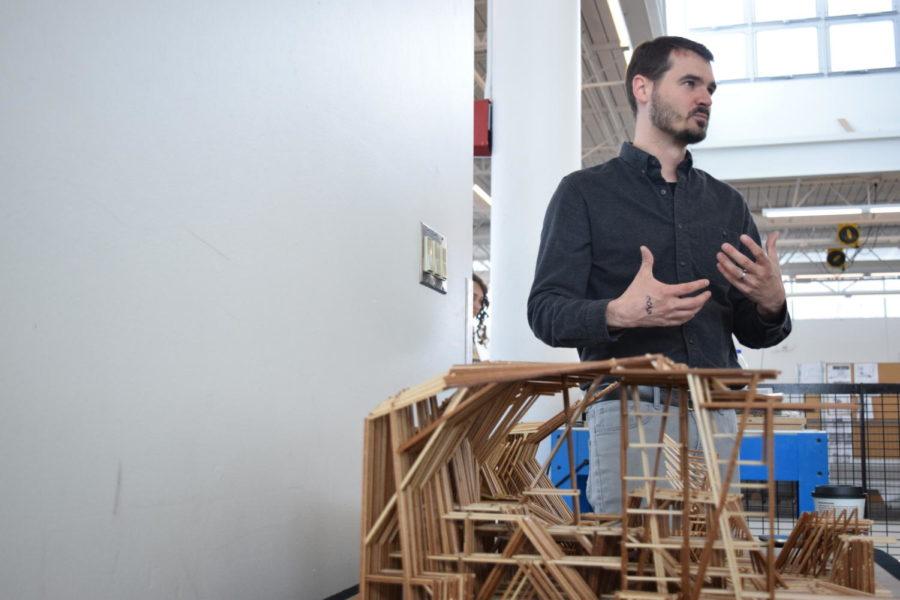Architecture students draw inspiration from Dunescape
Assistant Professor in Architecture Nick Senske talks about the Dunescape project that his class is working on for their Design 202 class. The end result will be a pavilion that can be used for students to hang out on during the summer months.
February 10, 2016
This art is meant to be sat on.
ISU class Architecture 202 is drawing inspiration from Dunescape for its latest project involving an unusual art tool.
Dunescape is a project completed in 2000 by SHoP architects. The design won Warm Up 2000, a contest sponsored by Museum of Modern Art and P.S.1 Contemporary Art Center.
The design of Dunescape is meant to allow people to enjoy summer weather. The structure, a summer pavilion made entirely from exposed 2-by-2 and 2-by-4 lumber, offers space to lounge, socialize and wade in pools.
“[Dunescape is] envisioned as basically a giant rolling dune that people would sit on in their bathing suits,” said Nick Senske, assistant professor of architecture. “Not exactly what you’d think of in the winter in Ames, Iowa.”
Students in the studio are currently in their second semester of the architecture program. The studio builds on basic design principles such as space, scale and drawing, which students learned during the fall semester.
A number of factors cause the two projects to be unique of each other, including the COD’s restraints and the different time period. Dunescape is purely a reference for the studio.
In fact, the studio contacted the SHoP architects to tell them they were using their project for inspiration. SHoP responded with photos that haven’t been released before, and a thank you.
“[SHoP], for all kinds of reasons, can’t really comment on it, but they didn’t tell us to stop doing it, so that’s nice,” Senske said.
Dunescape is a good example of a project designed for a public space, something students are learning through their project, which they have taken to calling “Two by Two.”
Before beginning their designs, students observed the College of Design atrium for one week. With their observations, they were able to design their own public space. The end project will have space for students to sit, lounge and study.
The students’ effort is unique because it is a design-build project. Some classes in the College of Design are design-build-based, but it isn’t required. Architecture 202 is, and this is the first time the studio has done something like this.
“The intention of this project was for [students] to actually design something and then learn about the construction process first-hand,” Senske said. “They not only have to design it, they have to make the drawings for it, they have to fabricate the pieces for it, they have to build it.”
The project is representative of a real-life project. There are five sections of the studio that meet at the same time and in the same space, and each have designed one-fifth of the project. This teamwork involved students collaborating and compromising, a realistic depiction of the work of architects.
“We’ve really kind of come together as a whole 80-person class in a way that’s really been good for ideas and productivity,” said sophomore Megan Zeien, sophomore in architecture-professional design.
From the final design stage to the installation, the project will last a total of four weeks.
Like Dunescape, the project is constructed from lumber.
“There’s no debate on what kind of structural system we need or what kind of material pallet we have; Dunescape provided us with that process,” Senske said. “It was up to us, basically, to design our version of it for the atrium and then to actually, you know, fabricate the damn thing.”
Each student has a different role in the construction.
For many of the students, the project is their first involving power tools and other construction devices.
The project makes Samuel Rezac, junior in architecture, feel like he’s a part of a miniature architecture firm.
“You go through every process that a firm would go through, from fabrication to assembly,” Rezac said.
On top of building the project, there are students are making posters, writing about it and creating a time lapse video of the construction.
The studio hopes this is a project prospective students, students from other colleges in the university and alumni will see.
“It’s a very public gesture,” Senske said of the project.
Over the course of three to four days the project will be installed. It will replace half of the tables and chairs in the COD atrium for one week starting on Feb. 17. Afterwards, it will be moved elsewhere, although the next location is not yet determined.







